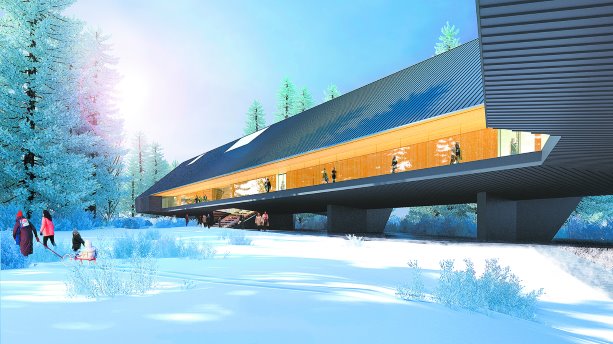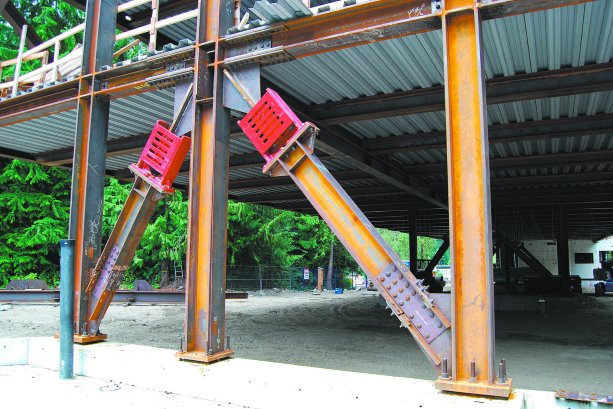When the privately-funded Audain Art museum in Whistler, British Columbia is open in October of this year, it won’t be just the artists and their patrons receiving accolades.
Also taking bows will be the designers and builders of the arc shaped steel structure which touches the ground in just six places and cantilevers in all directions from the foundations.
Designed by Vancouver-based architects Patkau Architects and structural consultant Equilibrium Consulting Inc. and built by Axiom Construction, the 5,100-square-metre (54,896 sq. ft.) museum is being built with 1,000 tons of ninety-per cent recycled steel.
It is also the first building in the world to incorporate a new earthquake-resistant technology developed over a five-year period by the University of Toronto.
Twelve high-performance cast-steel high-ductility "Scorpion Yielding Connectors" (SYC) have been installed at the museum.
In the event of an earthquake, they will function almost like a giant shock absorber, says Michael Gray, one of the university researchers and co-founder of Cast Connex Corporation, a Toronto engineering firm which has the exclusive commercial, distribution, supply and other product rights.
"In an earthquake, non-linear response in a SYC is isolated to the brace assembly while the other elements of the frame, such as beams, columns and gusset plates, are intended to remain predominately elastic."
A brace in a SYC consists of two cast steel connectors fastened to the end of a W-shape or other structural member. Each connector is made up of an arm and a series of fingers and is produced from a highly ductile, notch-tough cast steel grade. In a brace assembly, the fingers of both connectors are bolted to a splice plate which is connected to the beam-column intersection through a traditional gusset plate connection. The other end of the brace is connected to the beam-column, says Gray.
Development work on the Scorpion formed part of his doctoral research.
Asked how the Scorpion made the leap from the laboratory to a startup product and to the construction site, Gray says both Equilibrium Consulting and steel fabricator George Third & Son were very familiar with the product.
The Scorpion Yielding Connectors are very important to this project, but they are just one of the engineering and design dynamics of the museum.
Located on a flood plain near a creek, the building is elevated one-storey above ground and is supported on isolated pad footings and frames spaced 20 metres (65 feet) apart.
The long span structure consists of a three dimensional steel frame, with concrete composite steel deck floor slabs, while the roof is comprised of prefabricated engineered wood panels, says Equilibrium Consulting principal Eric Karsh.
"The seemingly simple structure, as imagined from the outside form, is surprisingly complex as it responds to demanding internal program requirements."
A series of sloping trusses, which are interrupted by large openings to suite the flow of the open gallery inside, make up that framework, says Rob Third, president of George Third & Son.
Fabrication of the steel started in January 2014 and will be finished this February, says Third, pointing out his firm is part of a "One, Two, Three, Team" which includes detailer Somerset Engineering, and KWH Constructors, the steel erection firm. "We do most projects together."
As part of the pre-construction planning, the three firms met on an almost daily basis with Equilibrium Consulting to review the 3D modelling and shop drawings, he says.
Fabrication of the steel, which included the convoluted trusses, beams, columns, and braces, started in April 2014.
Although some trusses were assembled on site before lifting, 90 per cent had to be erected one piece at a time, because of the location and tight site conditions in a forested area, says Third.
British Columbia’s Sea to Sky Highway, which goes through mountainous terrain, "also limited our ability to ship oversized loads."
With the exception of an architectural steel and glass canopy, which will be installed in March, the steel component is basically completed, says Third.
Funded by real estate developer and philanthropist Michael Audain, the museum will showcase one of Canada’s largest collections of private art, including indigenous and contemporary British Columbia art.





Recent Comments
comments for this post are closed